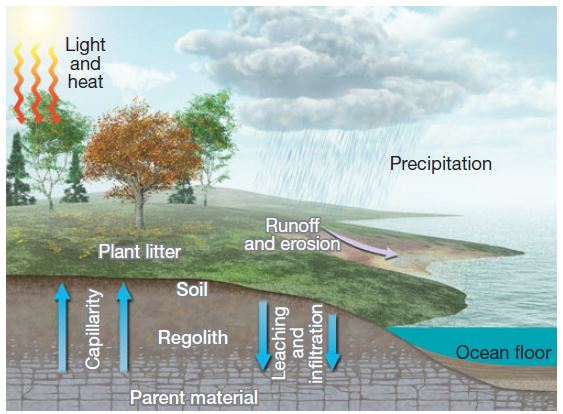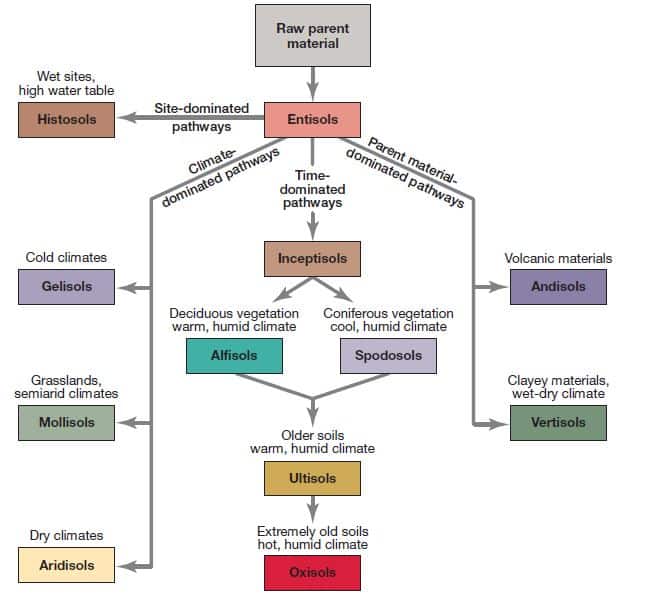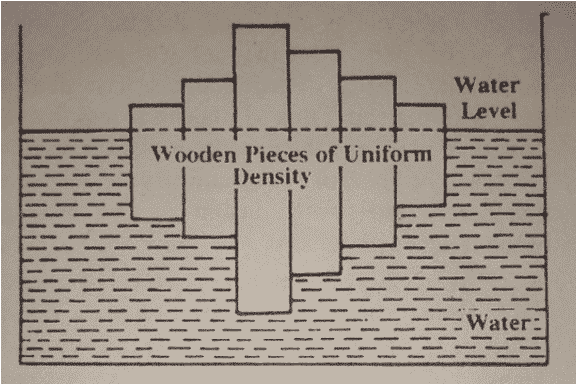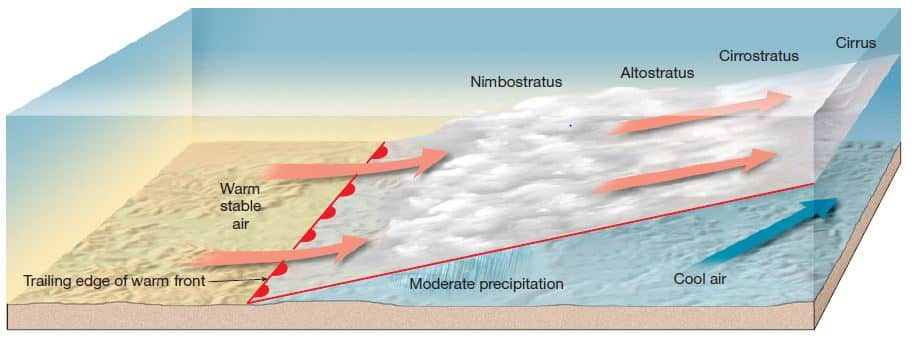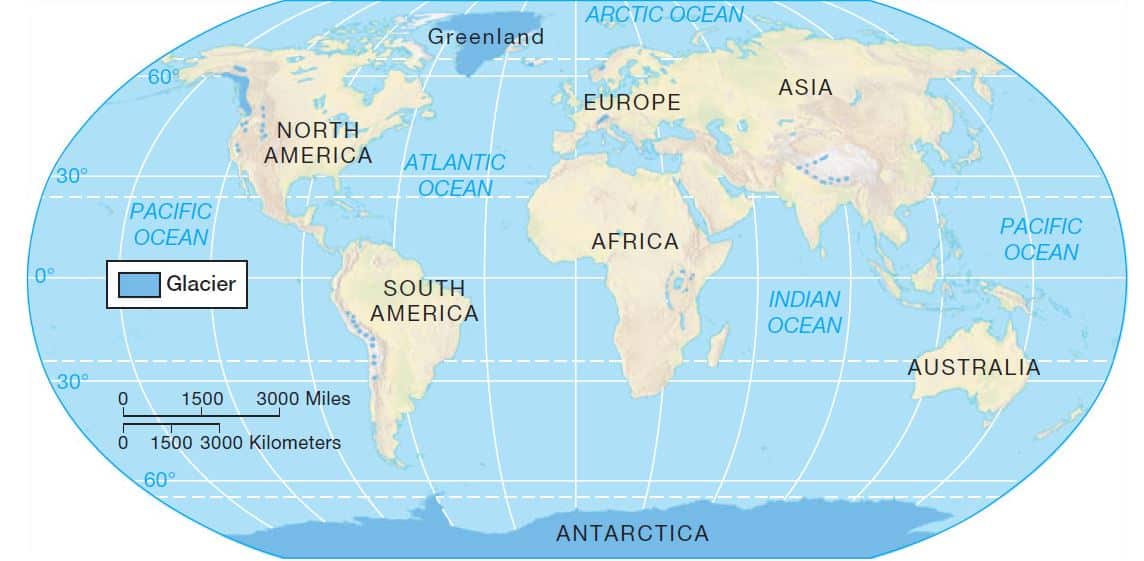Table of Contents
Genesis of Soil Structure | Geography Optional | UPSC IAS
Although the lithosphere encompasses the entire planet, from surface to core, the part that holds our attention here is soil, the topmost layer. Soil is the essential medium in which most terrestrial life is nurtured. Almost all land plants sprout from this precious medium, spread so thinly across the continental surfaces that it has an average worldwide depth of only about 15 centimeters (6 inches).
Despite the implication of the well-known simile “as common as dirt,” soil is remarkably diverse. It is a nearly infinitely varying mixture of weathered mineral particles, decaying organic matter, living organisms, gases, and liquid solutions.
- Preeminently, however, soil is a zone of plant growth. Soil is a relatively thin surface layer of mineral matter that normally contains a considerable amount of organic material and is capable of supporting living plants.
- It occupies that part of the outer skin of Earth that extends from the surface down to the maximum depth to which living organisms penetrate, which means basically the area occupied by plant roots. Soil is characterized by its ability to produce and store plant nutrients, an ability made possible by the interactions of such diverse factors as water, air, sunlight, rocks, plants, and animals.
- Although thinly distributed over the land surface, soil functions as a fundamental interface where atmosphere, lithosphere, hydrosphere, and biosphere meet. The bulk of most soil is inorganic material, so soil is usually classified as part of the lithosphere, but it is intimately related to the other three Earth spheres.
Image – Vertical cross section from surface to bedrock, showing the relationship between soil and regolith
Genesis of Soil Structure | UPSC IAS
Soil development (Genesis of Soil Structure) begins with the physical and chemical disintegration of rock exposed to the atmosphere and to the action of water percolating down from the surface. This disintegration is called weathering. The basic result of weathering is the weakening and breakdown of solid rock, the fragmentation of coherent rock masses, and the making of little rocks from big ones.
- The principal product is a layer of loose inorganic material called regolith (“blanket rock”) because it lies like a blanket over the unfragmented rock below. Typically then, the regolith consists of material that has weathered from the underlying rock and that has a crude gradation of particle sizes, with the largest and least fragmented pieces at the bottom, immediately adjacent to the bedrock.
- Sometimes, however, the regolith consists of material that was transported from elsewhere by the action of wind, water, or ice. Thus, the regolith may vary significantly in composition from place to place.
- The upper half meter or so of the regolith normally differs from the material below in several ways, most notably in the intensity of biological and chemical processes taking place.
- This upper portion is soil. It is composed largely of finely fragmented mineral particles, and is the ultimate product of weathering. It normally also contains an abundance of living plant roots, dead and rotting plant parts, microscopic plants and animals both living and dead, and a variable amount of air and water. Soil is not the end product of a process, but rather a stage in a neverending continuum of physical – chemical–biological processes.
Image explanation – Soil develops through a complex interaction of physical, chemical, and biological processes. Parent-material bedrock weathers to regolith, and then plant litter combines with the regolith to form soil. Some of that soil washes to the ocean floor, where, over the expanse of geologic time, it is transformed to sedimentary rock. Someday that ocean floor may be uplifted above sea level and the exposed sedimentary rock will again be weathered into soil.
Genesis of Soil Structure – Principal Soil Forming Factors | UPSC IAS
Soil is an ever-evolving material. Metaphorically, soil acts like a sponge – taking in inputs and being acted upon by the local environment – changing over time and when the inputs or local environment change. Five principal soil forming factors are responsible for soil development:
- Geology,
- Climate,
- Topography,
- Biology, and
- Time
Genesis of Soil Structure – The Geologic Factor | UPSC IAS
The source of the rock fragments that make up soil is parent material, which may be either bedrock or loose sediments transported from elsewhere by water, wind, or ice. Whatever the parent material, it is sooner or later disintegrated and decomposed at and near Earth’s surface, providing the raw material for soil formation. The nature of the parent material often influences the characteristics of the soil that develop from it; this factor sometimes dominates all others, particularly in the early stages of soil formation.
- The chemical composition of parent material is obviously reflected in the resulting soil, and parent–material physical characteristics may also be influential in soil development, particularly in terms of texture and structure.
- Bedrock that weathers into large particles (as does sandstone, for example) normally produces a coarse-textured soil, one easily penetrated by air and water to some depth. Bedrock that weathers into minute particles (shale, for example) yields fine-textured soils with a great number of pores but of very small size, which inhibits air and water from easily penetrating the surface.
- Young soils are likely to be very reflective of the rocks or sediments from which they were derived. With the passage of time, however, other soil-forming factors become increasingly important, and the significance of the parent material diminishes.
- Eventually the influence of the parent material may be completely obliterated, so that it is sometimes impossible to ascertain the nature of the rock from which the soil evolved.
Genesis of Soil Structure – The Climatic Factor | UPSC IAS
Temperature and moisture are the climatic variables of greatest significance to soil formation. As a basic generalization, both the chemical and biological processes in soil are usually accelerated by high temperatures and abundant moisture and are slowed by low temperatures and lack of moisture.
- One predictable result is that soils tend to be deepest in warm, humid regions and shallowest in cold, dry regions. It is difficult to overemphasize the role of moisture moving through the soil.
- The flow is mostly downward because of the pull of gravity, but it is sometimes sideways in response to drainage opportunities and sometimes, in special circumstances, even upward. Wherever and however water moves, it always carries dissolved chemicals in solution and usually also carries tiny particles of matter in suspension. Thus, moving water is ever engaged in rearranging the chemical and physical components of the soil, as well as contributing to the variety and availability of plant nutrients.
- In terms of general soil characteristics, climate is likely to be the most influential factor in the long run. This generalization has many exceptions, however, and when soils are considered on a local scale, climate is likely to be less prominent as a determinant.
Genesis of Soil Structure – The Topographic Factor | UPSC IAS
Slope and drainage are the two main features of topography that influence soil characteristics. Wherever soil develops, its vertical extent undergoes continuous, if usually very slow, change. This change comes about through a lowering of both the bottom and top of the soil layer. The bottom slowly gets deeper as weathering penetrates into the regolith and parent material and as plant roots extend to greater depths. At the same time, the soil surface is being lowered by sporadic removal of its uppermost layer through normal erosion, which is the removal of individual soil particles by running water, wind, and gravity.
- Where the land is flat, soil tends to develop at the bottom more rapidly than it is eroded away at the top. This does not mean that the downward development is speedy; rather it means that surface erosion is extraordinarily slow. Thus, the deepest soils are usually on flat land. Where slopes are relatively steep, surface erosion is more rapid than soil deepening, with the result that such soils are nearly always thin and immaturely developed. If soils are well drained, moisture relationships may be relatively unimportant factors in soil development. If soils have poor natural drainage,
- However, significantly different characteristics may develop. For example, a waterlogged soil tends to contain a high proportion of organic matter, and the biological and chemical processes that require free oxygen are impeded (because air is the source of the needed oxygen and a waterlogged soil contains essentially no air).
- Most poorly drained soils are in valley bottoms or in some other flat locale because soil drainage is usually related to slope. In some cases, such subsurface factors as permeability and the presence or absence of impermeable layers are more influential than slope.
Genesis of Soil Structure – The Biological Factor | UPSC IAS
From a volume standpoint, soil is about half mineral matter and about half air and water, with only a small fraction of organic matter. However, the organic fraction, consisting of both living and dead plants and animals, is of utmost importance. The biological factor in particular gives life to the soil and makes it more than just “dirt.” Every soil contains a quantity (sometimes an enormous quantity) of living organisms, and every soil incorporates some (sometimes a vast amount of) dead and decaying organic matter.
- Vegetation of various kinds growing in soil performs certain vital functions. Plant roots, for instance, work their way down and around, providing passageways for drainage and aeration, as well as being the vital link between soil nutrients and the growing plants.
- Many kinds of animals contribute to soil development as well. Even such large surface-dwelling creatures as elephants and bison affect soil formation by compaction with their hooves, rolling in the dirt, grazing the vegetation, and dropping excreta. Ants, worms, and all other land animals fertilize the soil with their waste products and contribute their carcasses for eventual decomposition and incorporation into the soil. Many small animals spend most or all of their lives in the soil layer, tunneling here and there, moving soil particles upward and downward, and providing passageways for water and air.
- Mixing and plowing by soil fauna is sometimes remarkably extensive. Ants and termites, as they build mounds, also transport soil materials from one layer to another. The mixing activities of animals in the soil, generalized under the term bioturbation, tend to counteract the tendency of other soil-forming processes to accentuate the vertical differences among soil layers.
- The abundance and variety of animal life connected with the soil are quite surprising. Such organisms vary in size from the gigantic to the microscopic, and in numbers from a few per hectare to billions per gram. The organic life of the soil ranges from microscopic protozoans to larger animals that may accidentally alter certain soil characteristics. Of all creatures, however, it is probable that the earthworm is the most important to soil formation and development.
The Biological Factor – (i) – Earthworms | UPSC IAS
The cultivating and mixing activities of earthworms are of great value in improving the structure, increasing the fertility, lessening the danger of accelerated erosion, and deepening the profile of the soil. The distinctive evidence of this value is that the presence of many well- nourished earthworms is almost always a sign of productive, or potentially productive, soil.
- The mere presence of earthworms, however, does not guarantee that a soil will be highly productive, as there may be other kinds of inhibiting factors such as a high water table.
- Nevertheless, an earthworm-rich soil has a higher potential productivity than similar soils lacking earthworms. In various controlled experiments, the addition of earthworms to wormless soil has enhanced plant productivity by several hundred percent.
At least seven beneficial functions have been attributed to earthworms:
- Their innumerable tunnels facilitate drainage and aeration and the deepening of the soil profile.
- The continual movement of the creatures beneath the surface tends to bring about the formation of a crumbly structure, which is generally favorable for plant growth.
- The soil is further mixed by material being carried and washed downward into their holes from the surface. This is notably in the form of leaf litter dragged downward by the worms, which fertilizes the subsoil.
- The digestive actions and tunneling of earthworms form aggregate soil particles that increase porosity and resist the impact of raindrops, helping to deter erosion.
- Nutrients in the soil are increased by the addition of casts excreted by earthworms (casts are expelled by earthworms and consist of mineral material bound together with decomposed organic material), which have been shown to be 5 times richer in available nitrogen, 7 times richer in available phosphates, and 11 times richer in available potash than the surrounding soil.
- They rearrange material in the soil, especially by bringing deeper matter to the surface, where it can be weathered more rapidly. Where earthworms are numerous, they may deposit as much as 9000 kg/ hectare (25 tons/acre) of casts on the surface in a year.
- Nitrification is also promoted by the presence of earthworms, due to increased aeration, alkaline fluids in their digestive tracts, and the decomposition of earthworm carcasses. In many parts of the world, of course, earthworms are lacking. They are, for example almost totally absent from arid and semiarid regions. In these dry lands, some of the earthworm’s soil-enhancing functions are carried out by ants and earth-dwelling termites, but much less effectively.
The Biological Factor – (ii) – Microorganisms in the Soil | UPSC IAS
- Another important component of the biological factor is microorganisms, both plant and animal, that occur in uncountable billions. An estimated three-quarters of a soil’s metabolic activity is generated by microorganisms.
- These microbes help release nutrients from dead organisms for use by live ones by decomposing organic matter and by converting nutrients to forms usable by plants. Algae, fungi, protozoans, actinomycetes, and other minuscule organisms all play a role in soil development, but bacteria probably make the greatest contribution overall. This is because certain types of bacteria are responsible for the decomposition and decay of dead plant and animal material and the consequent release of nutrients into the soil.
Genesis of Soil Structure – The Time Factor | UPSC IAS
- For soil to develop on a newly exposed land surface requires time, with the length of time needed varying according to the nature of the exposed parent material and the characteristics of the environment.
- Soil-forming processes are generally very slow, and many centuries may be required for a thin layer of soil to form on a newly exposed surface. A warm, moist environment is conducive to soil development. Normally of much greater importance, however, are the attributes of the parent material. For example, soil develops from sediments relatively quickly and from bedrock relatively slowly.
The Time Factor – Soil Erosion | UPSC IAS
Most soil develops with geologic slowness – so slowly that changes are almost imperceptible within a human life span. It is possible, however, for a soil to be degraded, either through the physical removal associated with accelerated erosion or through depletion of nutrients, in only a few years.
- Soils that have fine textures – especially those with low rates of rainwater infiltration – tend to be those that are most easily eroded by rainwater runoff and wind;
- Steep slopes and lack of a vegetation cover also increase the likelihood of erosion. In regions where single-crop agriculture (“monoculture”) is practiced, fields are often left bare and unplanted for several months each year, increasing the likelihood of erosion.
- Estimates of the amount of agricultural land lost to soil erosion vary greatly. In the United States, some researchers estimate that nearly 40 percent of the productive soil in the wheat growing Palouse region of Washington and Idaho, and as much as 50 percent of the topsoil of Iowa, has been lost to erosion over the last 150 years.
- Globally, perhaps 10 million hectares of cropland are lost each year to soil erosion – a rate that is 10 to 40 times faster than productive soil can develop. It is important to realize that in the grand scale of geologic time, soil can be formed and reformed, but in the dimension of human time, it is a mostly nonrenewable resource.



